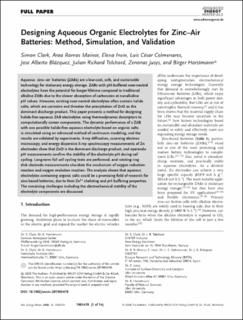| dc.contributor.author | Clark, Simon | |
| dc.contributor.author | Mainar, Aroa R. | |
| dc.contributor.author | Iruin, Elena | |
| dc.contributor.author | Colmenares, Luis C. | |
| dc.contributor.author | Blázquez, Alberto | |
| dc.contributor.author | Tolchard, Julian R | |
| dc.contributor.author | Jusys, Zenonas | |
| dc.contributor.author | Horstmann, Birger | |
| dc.date.accessioned | 2020-10-13T09:47:12Z | |
| dc.date.available | 2020-10-13T09:47:12Z | |
| dc.date.created | 2020-01-31T11:29:09Z | |
| dc.date.issued | 2020 | |
| dc.identifier.issn | 1614-6832 | |
| dc.identifier.uri | https://hdl.handle.net/11250/2682407 | |
| dc.description.abstract | Aqueous zinc–air batteries (ZABs) are a low‐cost, safe, and sustainable technology for stationary energy storage. ZABs with pH‐buffered near‐neutral electrolytes have the potential for longer lifetime compared to traditional alkaline ZABs due to the slower absorption of carbonates at nonalkaline pH values. However, existing near‐neutral electrolytes often contain halide salts, which are corrosive and threaten the precipitation of ZnO as the dominant discharge product. This paper presents a method for designing halide‐free aqueous ZAB electrolytes using thermodynamic descriptors to computationally screen components. The dynamic performance of a ZAB with one possible halide‐free aqueous electrolyte based on organic salts is simulated using an advanced method of continuum modeling, and the results are validated by experiments. X‐ray diffraction, scanning electron microscopy, and energy dispersive X‐ray spectroscopy measurements of Zn electrodes show that ZnO is the dominant discharge product, and operando pH measurements confirm the stability of the electrolyte pH during cell cycling. Long‐term full cell cycling tests are performed, and rotating ring disk electrode measurements elucidate the mechanism of oxygen reduction reaction and oxygen evolution reaction. The analysis shows that aqueous electrolytes containing organic salts could be a promising field of research for zinc‐based batteries, due to their Zn2+ chelating and pH buffering properties. The remaining challenges including the electrochemical stability of the electrolyte components are discussed. | en_US |
| dc.language.iso | eng | en_US |
| dc.publisher | Published by WILEY-VCH Verlag GmbH & Co | en_US |
| dc.rights | Navngivelse 4.0 Internasjonal | * |
| dc.rights.uri | http://creativecommons.org/licenses/by/4.0/deed.no | * |
| dc.subject | ZAB | en_US |
| dc.subject | Zinc–air batteries | en_US |
| dc.subject | Energy storage | en_US |
| dc.subject | Electrolytes | en_US |
| dc.title | Designing Aqueous Organic Electrolytes for Zinc-Air Batteries: Method, Simulation, and Validation | en_US |
| dc.type | Peer reviewed | en_US |
| dc.type | Journal article | en_US |
| dc.description.version | publishedVersion | en_US |
| dc.rights.holder | © 2020 The Authors | en_US |
| dc.source.pagenumber | 14 | en_US |
| dc.source.volume | 10 | en_US |
| dc.source.journal | Advanced Energy Materials | en_US |
| dc.identifier.doi | 10.1002/aenm.201903470 | |
| dc.identifier.cristin | 1787896 | |
| dc.relation.project | EC/H2020/646186 | en_US |
| cristin.unitcode | 7401,80,62,0 | |
| cristin.unitname | Bærekraftig energiteknologi | |
| cristin.ispublished | true | |
| cristin.fulltext | original | |
| cristin.qualitycode | 1 | |

